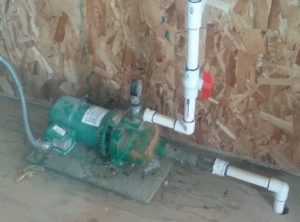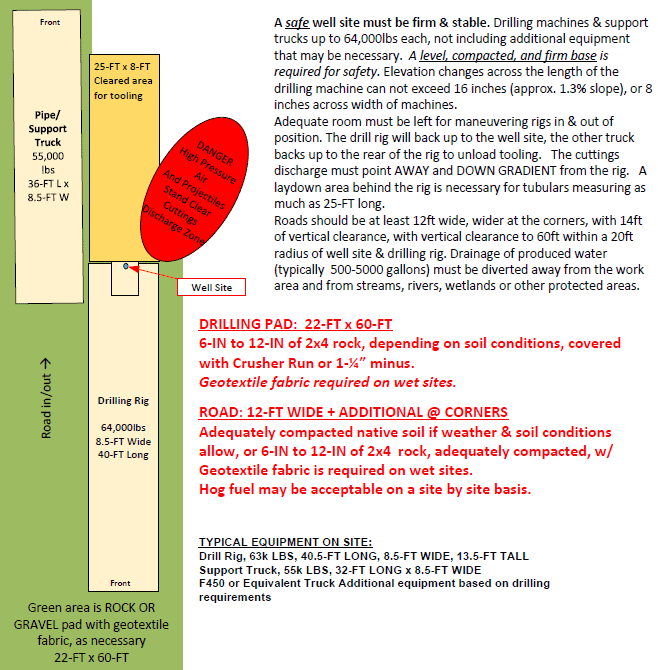FAQ – Well Owners
What kind of well do I have?
Drilled wells are constructed with steel or PVC casing, typically 6-IN in diameter (6.5 inches outside dimensions).
Dug wells are typically made of concrete or brick with a steel or concrete lid. Dug wells are common on very old properties or in the northern Snohomish County region, and less common in the greater King County area.

A drilled well on the left and a dug well on the right, the drilled well is 6-IN in diameter, the dug well is 36-IN in diameter.
What is the pressure tank used for?

Drawing of a typical submersible pump installation
A typical well pump system will have an 80 gallon pressure tank with a motor control box and pressure switch at the surface. When the pressure in the tank gets down to a certain point, the pressure switch closes, sends voltage to the control box, and the control box starts the well pump motor. The motor runs until the pressure reaches a certain high point, called the cut out, and the pump shuts off. This process repeats as necessary while you’re using water.
The pressure tank has an diaphragm with well water on one side, and air on the other. The air will compress between well pump cycles and is used to store the pressurized energy the well pump creates. When you open a faucet, the compressed air pushes the water out of the tank to the plumbing system. When the pressure gets low, the pump turns back on and rebuilds it. This is done to keep the pump from cycling on-off constantly, and to allow the pump to properly cool when it does turn on.
Newer pump systems use variable speed controllers, known as Variable Frequency Drives, or VFD’s for short. VFD’s allow the pump to run as an On Demand type system – the pressure starts to drop, the pump will start to run up to meet the demand. In the last 20 years they have become much more common, have a lot of more advanced features and reliable space saving appliances. VFD’s typically will allow for the use of much smaller pressure tanks than a typical system – 5-10 gallons is common. We still recommend larger tanks on higher flow VFD’s for pump impeller protection purposes.
Should I test my water?
Annually checking for bacteria is always a good idea and is recommended by the National Ground Water Association. If you have a dug well, more periodic checks for bacteria should be conducted, or a UV Water Purification system should be installed, as dug wells are highly susceptible to surface water intrusion.
If the well has ever tested positive for Arsenic, periodic checks during different times of the year should be conducted to establish a baseline. An EPA study in Granite Falls has found that some wells will seasonally vary the amount of arsenic in the water quite significantly, while some are very consistent. A series of quarterly checks through the year should do to establish whether your well seasonally varies. If your test results ever exceed 10 parts per billion, we recommend you contact a water systems engineer and have an arsenic filtration system designed.
Where can I get water testing done?
We can collect a sample for you and deliver it to AM Test Laboratories of Kirkland, or Edge Analytical of Burlington, or you can collect your own sample and deliver the sample yourself. The labs do have special bottles that area sterile and sealed for bacteria tests, but inorganic compounds like arsenic can be collected with a rinsed drinking water bottle.
FAQ – Well Pumps & Filtration
Do I have a Submersible or Jet pump?
A submersible pump is installed down near the bottom of the well, so the only indications of having one are typically that you can’t find it at the surface. A jet pump or centrifugal pump is found at the surface and it pulls water from the well – typically these are only installed on very shallow wells or storage tank systems. Some people have both – a submersible well pump that delivers water to above ground storage, and a jet pump to pull water from storage to deliver it to the house.

An example of an old jet pump system found in a well house.
How long does a well pump last?
Generally, 12-15 years for the motor and pump, sometimes longer, and some brands are more reliable than others. Often it depends on water chemistry and the conditions the pump was installed in. We’ve pulled pumps out of wells that were over 60 years old and still operating, but those are definitely the oddity. Most well pumps built after the early 1990’s have been constructed lighter to save energy and reduce costs, and this does appear to have reduced their life span.
What maintenance do I need to do to my well pump system?
Typically, pressure tanks should be checked annually for proper inflation pressure in the air diaphragm. The motor controller should be checked for failing capacitors/relays. The motor and wire to the motor should be checked for amperage, motor line-to-line resistance, and wire insulation effectiveness. Some of this work requires sophisticated testing equipment working in high-voltage enclosures and should only be conducted by qualified individuals. Give us a call and we can take a look at your system and make any adjustments that may be necessary.
My Well Pump Quit – When Can You Fix It?
When a well pump quits and the water stops, it feels like an emergency. We can often re-arrange our schedule to provide same-day or next-day service to get you back into water.
I haven’t had my well pump system looked at in 20 years, should I?
Absolutely! The best situation for everyone is that we discover a problem with your aging well system before it’s an emergency out-of-water situation, plan and order the right parts, and schedule the repair when it’s mutually convenient.
Do you have an Operations & Maintenance program or Annual Checkup program?
Not yet, but we’re working on it. If you’re interested in an annual check-up program or the like, give us a call.
Frequently Asked Questions for Drilling Customers
What is your lead time to drill a well?
This is dependent on our current contract backlog. We take contracts from people and get them worked through our process of getting on the list of ‘ready to go’ jobs. The “Ready To Go” list is our working list of jobs that we can get on, and is the measure of how far out we are. We take the jobs on a first-readied, first-served basis. In the first half of the year, we are often only 3-4 weeks out, and as the year goes on, this schedule increases to as much as 10 weeks in the peak of summer.
What are the total costs for a typical well system?
In Snohomish County, costs are typically lower than in King County. Our pricing system is designed to adapt to the constantly changing prices from our suppliers, we encourage you to contact us to work up an estimate for your property, rather than rely on a rule of thumb number that may not match the current costs.
What kind of road/pad do you need for machinery? What does it cost?
This is entirely site dependent, but please see this PDF file. We can make a site visit to help you determine the access requirements, but we are not excavation professionals, and can only provide our opinion in regard to access requirements.

Recommended drilling pad setup – if you can’t meet this particular setup, we can orient equipment in different ways to meet the site requirements.
We typically recommend a rock pad for the drill rig, and a rock road for access is necessary on a case-by-case basis. Our pipe and supply truck will make multiple trips in/out of the job site, so a road capable of trips will be necessary. In the driest months of the year, a rough-cut road without rock is often workable, or hog fuel is often adequate as well. During the rest of the year, hog fuel roads can work, but if there is standing water/soft soil, a road will be required that is built of geotextile fabric and/or rock. The drilling pad should be made of crushed rock, or structural soil in the driest months.
Please note that if the road/pad is not workable when we arrive with the machinery, you may be charged for another mobilization. If we get stuck on the job site due to inadequate access, we may be forced to call a professional towing company to tow us out, and bill for standby time for our time loss on the job.
Costs are typically in the $2,000 to $10,000 range, but can be up to $30,000 or more for the most complicated sites. We do not provide this work, but we recommend you hire a knowledgeable excavation contractor to do the work.
How long will the project take?
The drilling portion takes 1-5 days typically, pump installation and testing a day, and the water quality analysis process typically takes 3-5 weeks to complete. After that, you will need to likely provide us with more infrastructure to complete the remainder of the installation, which will take us around 1-2 weeks to complete. These timelines obviously don’t include any lead time that we may have before starting work, or you may have for permitting/other construction.
How do you know if you will hit water?
We carefully research the wells surrounding your property and base our estimates off the data we gather during that work. If there is a chance or likelihood that water will not be found, we will try to make this abundantly clear in our estimates and verbal conversation. There are very few areas in Western Washington that commonly have dry wells. In most cases, there is at least some water available under any given piece of property, though sometimes it’s not within the budget of the client to drill a well deep enough to get it.
Will you need power on-site during work?
We bring our own generators as necessary to drill and test the well. When the final pump controls and/or filtration system is installed, we will need to connect them to your permanent power source to properly start up the equipment.
Should I build a well house?

A framing crew building a well house around an existing pressure tank and control setup.
For domestic water systems, it is not required that a separate well house be constructed, but careful consideration needs to be made for the footprint of the water system components. Often, a water system is the sum of one or more pressure tanks, filtration systems, and/or holding tanks and booster pumps. It’s not very uncommon for this equipment to take up to 100 square feet of space.
For Group water systems, you will be required to build a well house. Consult with the engineer designing the system. At the minimum, we recommend a dedicated 10-FT x 10-FT structure that is frost free and has a concrete floor with a drain. Insulation, wall sheeting, lights, and a heat source as all required. Drawings of example well houses are available below.

Variable speed drive and control system installed in a direct bury application at the well without a wellhouse, typical for irrigation water systems.
For irrigation systems, many of our installations don’t require any structure and can be located below grade to prevent freezing.

